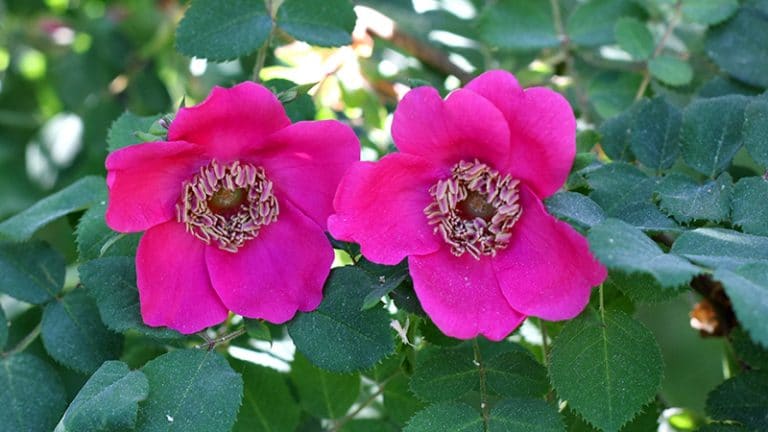
With frost upon us, the roses are getting ready for a long winter sleep. But don’t be fooled — their process of acclimatizing to winter dormancy is slow and gradual.
Dormancy is the most crucial element of winter hardiness, and roses require six to eight weeks of acclimatization before they enter full dormancy, ready to withstand the lowest winter temperatures. It’s not unusual to see some roses, such as ‘The Fairy’, blooming into mid-November, illustrating just how long a rose continues to function despite increasing cold.
The greatest danger period for roses is in the first two or three weeks of December, when some may not have completed the dormancy process. Although early December can be mild, it’s not unusual to experience a sharp temperature drop, significantly below freezing, and lasting for three to five days. This is disastrous timing for roses not yet fully dormant. With lingering moisture still in their tissues, they’re vulnerable to severe dieback of canes. When normally cold-hardy roses show lots of dead wood in spring, it’s often the result of frost damage in the early weeks of December, when they were still not fully dormant.
There’s not a lot we can do to prevent this circumstance. If early December gives us a sudden week of deep frost, then returns to milder temperatures, we can expect some damage in spring. But there are small steps we can take now to help keep a rose shrub healthy through whatever winter has in store.
It’s best to wait until spring to cut back rose canes. Pruning in spring means any twig dieback will be minimal. If canes and twigs are shortened in autumn, deep frost will cause tip and cane dieback, and we’ll be left with an even smaller shrub in spring. Long, thin canes of tall shrubs and climbers can be staked and tied before the ground freezes to keep them from whipping around in wind.
Like all shrubs and trees, roses require moisture in their soil during winter. Providing a good soaking before the ground freezes will see them through until the snow melts in spring. Spraying rose canes with an anti-desiccant product helps to prevent excessive moisture evaporation and sun scald on the canes.
Roses growing on their own roots may not require any further protection, but many of our garden roses are grafted plants. That means we’re dealing with the winter protection of two plants — the above-ground canes and the hardy root stock they’re grafted onto. The union of the two plants at the shrub’s crown is vulnerable, and should be carefully protected. The easiest and best method in our cold climate is to set the rose crown two to four inches (5 to 10 cm) below soil level on planting day. Some exceptionally frost-hardy roses, such as the Canadian Explorer and Parkland collections, are able to survive winter with no further consideration. But other shrub and climbing roses will benefit from the traditional hilling of soil around the crown to provide additional frost protection.
It’s best to wait until just before the soil freezes hard to hill roses. This late hilling allows the rose to feel the full impact of lowering soil and air temperatures, and hopefully encourages dormancy to proceed. I dump the soilless mix used in my containers over each rose crown, then follow up with a nice big pile of leaves over that. Alternatively, gather soil from another part of the garden and use that for hilling (don’t take it from over the rose roots), or buy a bag of potting soil to dump over each rose plant.
However you decide to hill the roses (and even if you don’t hill them at all), give the plants lots of leaves around and over the crowns. Leaves are wonderful insulation, and will make a nutritious mulch when you pull them back in spring and spread them out over the root zone. Lay dead twigs and slim branches from trees and shrubs (low branches from conifers are good for this) over the leaves to keep them in place, and then it’s sleepy time for roses.










Great article thanks Judith
I am a little confused about exactly when in zone 5 to hill root ball,
You mention dec can have sharp decline in temperature for day’s followed by warmer temperature which causes spring die back because roses have not completed their cycle. Later you state that hilling should not be done until ground freezes. In my experience the ground is almost never frozen until mid to late dec. As a professional Gardner I can be found planting bulbs Into early dec. and the ground is still not frozen by then.
Can you clarify when hilling is ideally done in zone 5.?
Thanks Suzanne
Hilling should be done when the ground is frozen–could be mid-December or late December. The hilling helps protect the bud unions on grafted roses from deeper freezing in extreme winter temperatures. The hilling material (soil, compost, leaves) must be gathered in advance and protected from freezing so that it can be used at this later time. Remove the hilling material in mid-spring when frost danger is not expected and cane buds are breaking. Fluctuating temperatures in December can affect dieback on rose canes that haven’t reached full dormancy (hence the recommendation not to cut back canes in fall). Hope this helps.
Yikes, I already hilled earth around before the hard freeze here in Ottawa but I can feel it coming very soon. Have I condemned my roses? Thanks for this article and the comments afterwards.. very helpful advice re pruning as I was contemplating whether to do that.
I live in zone 3 just north of Thunder Bay. We already have snow cover and last night it was -17C. I am able to grow zone 4 roses because I put lots of wood chips on the beds. I cover all my rose beds with at least 10 to 15 cm of arborist wood chips. As well I have low stone walls around my beds that trap early snow. If I want to retain long branches on some roses I will lay them on the ground with wood blocks to keep the canes down. The snow covers them and I don’t loose the canes to winter desiccation. Of course my roses are all on their own roots.
I want to compliment you on a very well written article. As an owner of a garden centre I am dealing with the dead roses our clients bring back in the spring and the mistake almost universally made is hard pruning in the fall (usually October) followed by entombment in a Styrofoam shell (which most garden centres refuse to sell). Thanks again – maybe if it’s heard often enough there will be fewer dead roses and a little less Styrofoam in landfills!
Doug King
Doug, you should not “warranty” Roses. I have been buying roses for a long, long time, online and from Garden Centres. If it is “alive” when I receive it, whatever happens afterwards, is my mistake. Cheers!
You do not mention putting any compost down at this time of year. I have usually put some sheep manure around the roses and then hilled up with mulched leaves and then some chipped wood. Should I be skipping the manure and only put it down in the spring?
Hi Penny,
Yes, certainly any kind of compost (garden made or aged animal manure) is fine in autumn. Compost contains low amounts of basic food plant nutrients and a broad spectrum of micronutrients, none of which would stimulate late growth in fall.
– Judith